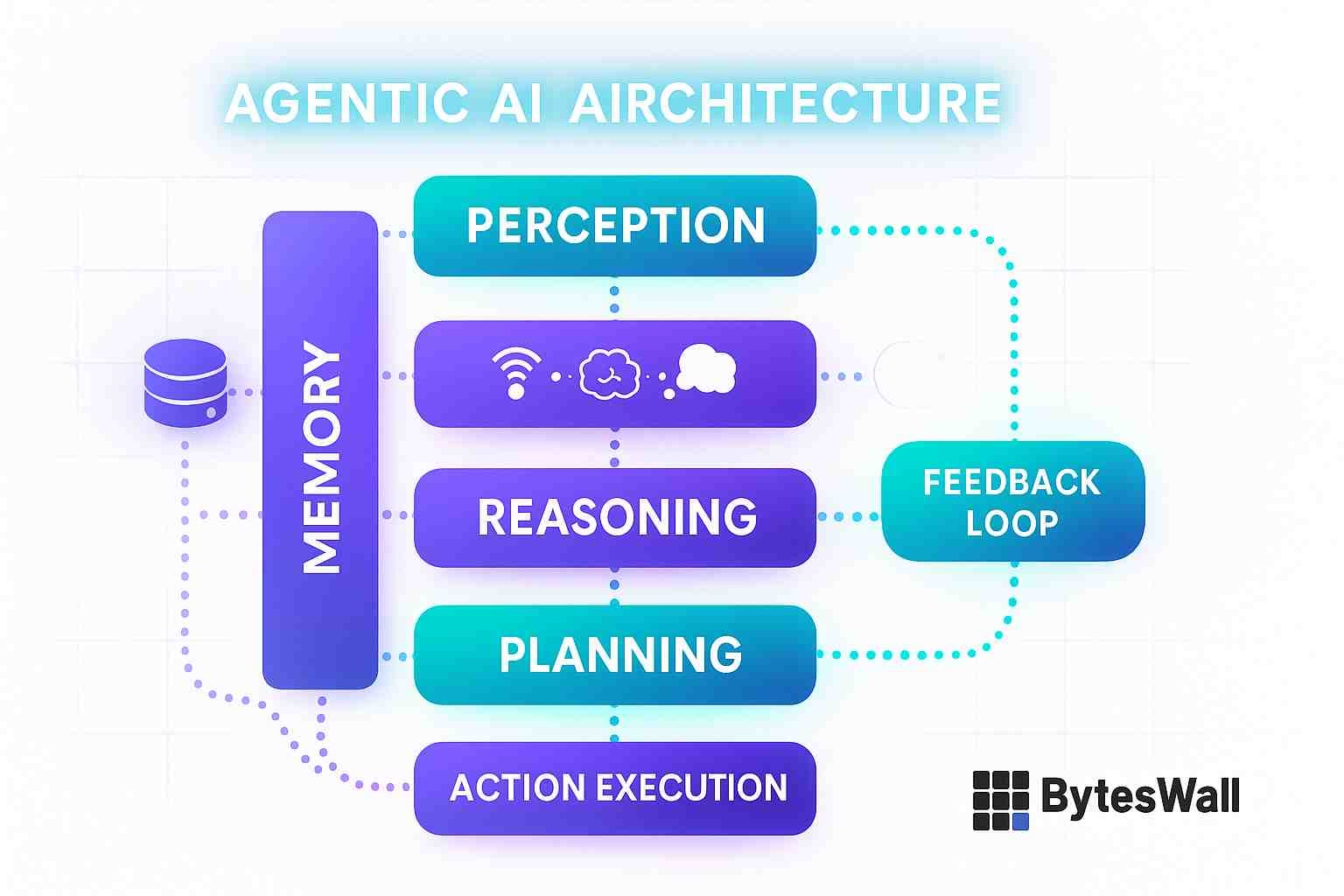Agentic AI in 2025: A Comprehensive Guide to Autonomous Intelligence

Agentic AI in 2025: A Comprehensive Guide to Autonomous Intelligence
Understanding Agentic AI: The Basics
Definition and Core Concept
Agentic AI refers to AI systems that operate autonomously, reasoning, planning, and acting to achieve specific goals without constant human oversight. Unlike traditional rule-based AI or supervised models, Agentic AI exhibits agency—adapting to dynamic environments and making decisions based on context. By 2025, Agentic AI is expected to automate enterprise workflows, driving a significant market, per Gartner.
Historical Context
Agentic AI evolved from early AI research in the 1980s, with multi-agent systems (MAS) and reinforcement learning (RL) laying the groundwork. The advent of large language models (LLMs) like GPT-4o and frameworks like LangChain accelerated its development, enabling complex reasoning and tool integration by 2023.
Key Trait: Agentic AI combines autonomy, adaptability, and goal-directed behavior, distinguishing it from passive AI systems.
Explore related trends in our Edge AI feature.
Core Components of Agentic AI
Perception
Agentic AI systems rely on perception to interpret and understand their environment. This involves processing data from various sources, such as sensors, APIs, or user inputs, to build a contextual understanding. For instance, an agent in a robotics application might use computer vision to detect obstacles.
Reasoning
Agentic AI relies on advanced reasoning to process complex inputs. Techniques like chain-of-thought (CoT) prompting and self-reflection allow agents to break down problems systematically.
Planning
Agents create actionable plans using algorithms like hierarchical task networks (HTNs) or Monte Carlo Tree Search (MCTS). These enable goal decomposition, such as scheduling a project by prioritizing tasks and allocating resources.
Action Execution
Once a plan is formulated, agents execute actions to achieve their goals. This involves interacting with external systems, such as sending commands to a robotic arm or updating a database through API calls, ensuring precise and timely task completion.
Tool Use
Agents integrate external tools via APIs, databases, or code execution. Claude 3.5 can call APIs to fetch weather data or update CRM systems, enhancing functionality.
Memory and Learning
Contextual memory stores past interactions, enabling agents to refine strategies. Long-term memory, as in Transformers, improves performance over stateless models.
Feedback Loops
Agents incorporate feedback loops to evaluate their actions and adjust strategies. For example, an agent might analyze the outcome of a task, learn from errors, and refine its approach for future iterations, ensuring continuous improvement.
Human-AI Interaction
Agents communicate via natural language, ensuring seamless collaboration. Tools like Microsoft Copilot integrate with Teams for intuitive interfaces.
Example: An Agentic AI assistant books travel by reasoning about preferences, planning flights, and using booking APIs.
Technical Foundations
Architectures
Agentic AI leverages diverse architectures:
- Single-Agent Systems: A single LLM (e.g., GPT-4o) handles tasks like email drafting or code generation.
- Multi-Agent Systems (MAS): Collaborative agents, as in MIT’s AutoGen, split tasks (e.g., one agent writes code, another debugs).
- Hybrid Systems: Combine LLMs with RL, as in DeepMind’s AlphaCode, for adaptive learning.
The architecture of an Agentic AI system typically includes interconnected layers for perception, reasoning, planning, and action execution, all supported by memory and feedback mechanisms.


Communication Protocols in Multi-Agent Systems
In multi-agent systems, agents rely on communication protocols to collaborate effectively. Protocols like FIPA ACL (Foundation for Intelligent Physical Agents Agent Communication Language) define standards for message exchange, enabling agents to share goals, plans, and data. For instance, an agent might use a protocol to negotiate task assignments with another agent, ensuring efficient orchestration.
Algorithms
Key algorithms include:
- Proximal Policy Optimization (PPO): Used in RL for optimizing agent actions (arXiv).
- MCTS: Enhances planning in dynamic environments, as in robotics.
- Contrastive Learning: Improves reasoning by comparing scenarios, used in Llama 4.
Frameworks
Popular frameworks include:
- LangChain: Enables tool integration and memory management (LangChain).
- AutoGen: Supports MAS for collaborative workflows.
- CrewAI: Simplifies agent orchestration for enterprise use.
Applications Across Industries
Healthcare
Agentic AI streamlines diagnostics and care. Google’s Med-PaLM triages patients, reducing wait times (Google AI). Agents reason over symptoms, plan tests, and integrate EHR data.
Finance
In finance, agents automate trading and fraud detection. JPMorgan’s COiN platform processes contracts efficiently (JPMorgan).
Logistics
Agents optimize supply chains. DHL’s AI agents reroute shipments in real-time (McKinsey).
Education
Personalized learning agents, like those from Khan Academy, adapt curricula to enhance student outcomes.
Robotics
Boston Dynamics’ Spot uses Agentic AI for inspections, minimizing downtime (Boston Dynamics).
Creative Industries
Agents assist in design and content creation, as in Adobe’s Firefly, enhancing productivity.
Challenges and Ethical Considerations
Technical Challenges
Agentic AI faces:
- Robustness: Misinterpreted goals can lead to errors. Advanced error handling, like self-correction models, mitigates this.
- Scalability: Coordinating thousands of agents is complex. Frameworks like CrewAI optimize MAS.
- Latency: Real-time tasks require low-latency systems, addressed by edge integration.
Ethical and Safety Issues
Key concerns include:
Future of Agentic AI
Generalist Agents
By 2030, agents will handle cross-domain tasks, reducing specialization needs (Gartner).
Human-AI Synergy
Agents will augment human creativity, as in NVIDIA’s Omniverse, enhancing design workflows.
Edge and Cloud Integration
Combining Agentic AI with Edge AI, per our Edge AI post, will enable ultra-low-latency applications.
Agentic AI Lifecycle
The lifecycle of Agentic AI includes several stages: design, where goals and capabilities are defined; training, where agents learn from data and simulations; deployment, where agents operate in real-world environments; and evolution, where feedback loops and updates improve performance over time. Understanding this lifecycle is key to leveraging Agentic AI effectively.
Societal Impacts
Agentic AI could automate many jobs by 2035, raising economic and ethical questions (WEF).
Join the Agentic AI Revolution
Agentic AI is 2025’s frontier. Start your journey:
- Learn with LangChain’s tutorials (free, ~5 hours).
- Build agents using Hugging Face’s models.
- Join r/AgenticAI for insights.
- Share projects on X with #AgenticAI2025 and tag @BytesWall.
Engage with BytesWall’s AI community to shape tomorrow’s intelligence.
Master Agentic AI! Explore more at BytesWall.com.